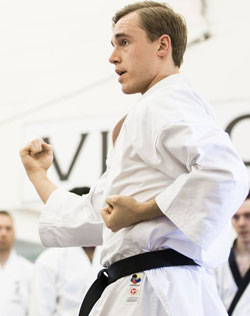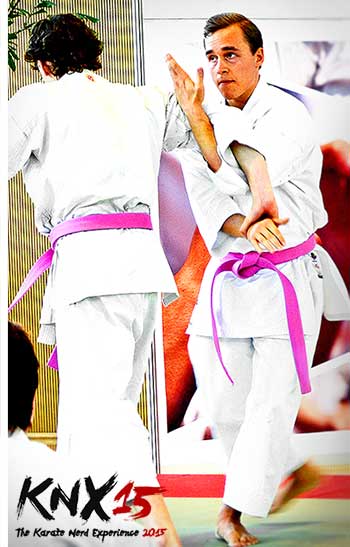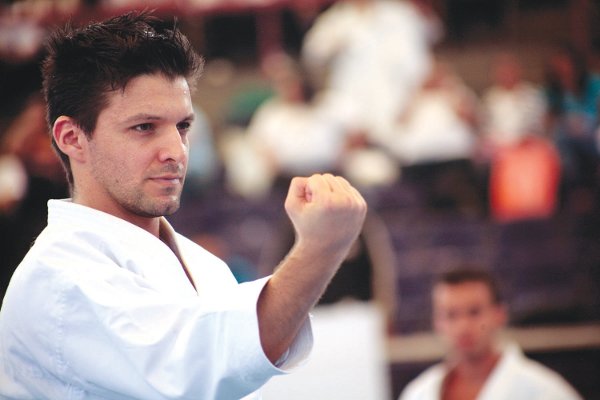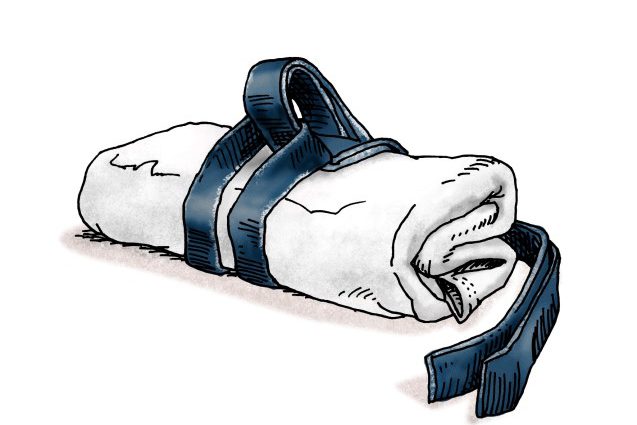Karate can be tricky.
Especially when we use Japanese terms.
Just like Medicine has Latin, and Mathematics has numbers, Karate has Japanese.
Unfortunately, many people are confused by the Japanese words in Karate….
But if you don’t understand the terminology of Karate, you cannot learn or teach it optimally.
That’s why I want to explain 10 Japanese words everyone misunderstands in Karate today.
Hopefully this helps you understand Karate better.
Check it out:
#1: Uke
Misunderstood meaning: “Block.”
Real meaning: “Receive.”
Explanation: The word “uke” comes from the Japanese word “ukeru”, which means “to receive”.
But for some reason, the Western world has interpreted this as “to block”.
To me, that’s the opposite of receiving! This is detrimental to your advancement in Karate and doesn’t reflect the original intent of Karate’s defensive moves.
If you shift your mindset from “blocking” to “receiving”, your entire perception of how to apply Karate against a bigger or stronger opponent will change. Now you rely more on technique, and less on brute force.
This is something I teach at my international seminars.
Related reading: Your Karate “Blocks” Are Dysfunctional. Here’s Why.
#2: Ki
Misunderstood meaning: “Magic super power.”
Real meaning: “Energy.”
Explanation: The concept of “ki” (spelled “chi” or “qi” in Chinese) has gotten a bad reputation since McDojo charlatans started using it as an excuse to brainwash students into believing they had supernatural martial abilities – like the no-touch KO.
But it’s really nothing new. “Ki” – or “energy” as we call it in English – is what life is made up of. It constantly flows through your body, your surroundings, the wind, water, earth and sun.
According to the laws of physics, you cannot create it or destroy it, only transferred to other objects or convert into different forms (kinetic energy, potential energy, thermal energy, electrical energy etc…). Humans have been cultivating it for as long as we have been on earth.
I believe “Ki” is a beautiful thing – especially when you manifest it using the body mechanics of Karate.
After all, Karate is all about efficient energy management.
Related reading: “Use The Force”: Exploring The Secret of Ki Power
#3: Sensei
Misunderstood meaning: “Karate instructor.”
Real meaning: “One who has come before in life.”
Explanation: The word “sensei” consists of two parts:
- The first is “sen”, which means “before”.
- The second is “sei”, which means “life”.
In other words, a “sensei” is someone who is ahead of you in the journey of life. That’s why a sensei is not just a person who instructs Karate techniques.
A sensei is your mentor. Your life coach.
Your sensei can help you bridge the gap between self-protection and self-perfection.
Because ultimately, the Way of Karate is the Way of Life.
Your sensei knows this, because he/she has walked the path himself and is ready to guide you on the journey.
The question is, are you ready to follow?
Related reading: 3 Secrets to Being a Karate Instructor That Kids L-O-V-E (& Respect)
#4: Bunkai
Misunderstood meaning: “Practical application of kata.”
Real meaning: “To break down.”
Explanation: Many Karate people, including me, like to use kata techniques for self-defense.

(After all, that was their original intent.)
We usually call this aspect of Karate training “bunkai”.
But in reality, “bunkai” means to “to break down” – not “practical application of kata”.
“Bunkai” is actually just the first step of applying kata for practical self-defense.
After you “break down” the kata, you need to analyze the pieces and put it back together in the right context. I outlined this in my popular article titled The Bunkai Blueprint.
For most people, it seems the word “bunkai” represents this whole process though.
That’s why I use the word “bunkai” like this myself, even though I know it’s incorrect. After all, the purpose of terminology is to communicate – not prove a point.
However, when I’m in Japan or Okinawa, I rarely use the word “bunkai” if I want to know the application of a kata move.
I use the word “imi” instead (lit. the “meaning” of a movement).
Related reading: 10 Differences Between Okinawan Karate & Japanese Karate
#5: Dojo
Misunderstood meaning: “Karate studio.”
Real meaning: “The place of the Way.”
Explanation: Many instructors teach Karate in gyms, dance studios, community centers or other venues not dedicated solely to Karate.
But… no matter where you teach/learn Karate, that place is your “dojo”.
(This holds true for all traditional Japanese martial arts.)
And the word “dojo” is deeper than most people think:
- “Do” means “Way”
- “Jo” means “Place”.
In other words, a “dojo” is a place where you embark on the journey to self-discovery – through the means of Karate training.
The “dojo” is a Place where you are guided on the Way, by someone who has “come before” ( = “sensei”), using Karate as tool for transmitting the knowledge necessary to spark personal progress.
Not just a “Karate studio”.
Related reading: 59 Signs Your Dojo is Awesome
#6: Geri
Misunderstood meaning: “Kick.”
Real meaning: “Diarrhea.”
Explanation: Those of you who subscribe to my weekly videos (Karate Nerd Insider™) probably choked on your coffee when you first heard this.
But it’s true!
Japanese is a funny language…
If you want to say “kick”, it’s pronounced “keri”.
But if you put another word in front of it, (like “mawashi”, “mae”, “yoko” etc.) it changes it to “-geri”
Look:
- “Keri” = “Kick”
- “Mawashi-geri” = “Round Kick”
- “Mae-geri” = “Front Kick”
- “Yoko-geri” = “Side Kick”
- “Geri” = “Diarrhea”
Of course, this is not a problem when you write in Japanese, because it’s written with a different Sino-Japanese ideogram (known as “kanji”.)
But if you don’t write Japanese, you should learn the difference between “keri” and “geri”.
Otherwise… you might end up in deep shit. ; -)
Related reading: Karate Nerd Insider™
#7: Kiai
Misunderstood meaning: “Battle scream.”
Real meaning: “Unified energy.”
Explanation: Sometimes it seems people scream “kiai” for the sake of screaming.
But “kiai” is not about screaming. It’s not about exercising your vocal chords.
- “Ki” literally means “energy” (like we discussed in #2).
- “Ai” literally means to “unify“.
This helps explains what the purpose of kiai truly is:
Unifying the total energy of your mind, body and technique (“shin-gi-tai”), in a split-second moment of intense culmination.
To some people, kiai is just a “battle scream”. And that’s fine. I honestly think people need to scream more in their daily life.
But to me, “kiai” it’s an essential expression of your unification within your Self.
Show me your “kiai”…
…and I will tell you who you are.
Related reading: What Every Karate-ka Should Know About “Kiai!”
#8: Rei
Misunderstood meaning: “Bow.”
Real meaning: “Respect.”
Explanation: Karate contains a lot of Japanese etiquette and culture.
One of the most important things is the bow – commonly known as “rei”.
The word “rei” comes from the Japanese word “reigi”, which means “respect, courtesy, manners”.
But the bow seems to have lost much of it’s respectful intention these days, especially when you look at people who compete in kumite. It looks more like a sloppy head nod.
I believe “rei” is an integral part of dojo etiquette. It’s a physical manifestation of your gratitude for those helping you on the Way.
That’s why we bow to both the dojo itself, as well as the people in it.
(Often we say “onegaishimasu” at the same time too.)
Without respect, you cannot progress in Karate.
Karate begins and ends with the bow.
Related reading: The Meaning of Onegaishimasu
#9: Kumite
Misunderstood meaning: “Sparring/fighting.”
Real meaning: “Entangled hands.”
Explanation: The modern concept of “kumite” has lost much of it’s essence.
When you look at the way we practice “kumite” today, it seems like a game of tag.
Distant, jerky & disconnected.
But the original intent of Karate’s two person combative exchange was very different.
You see, the word “kumite” actually means “entangled” or “intertwined” (“kumi”) + “hands” (“te”). Not “fighting”, “sparring” or “jumping around trying to score points”.
The concept of entangling/intertwining arms with your opponent sounds like you’re at a much closer distance, doesn’t it?
Interestingly enough, if you look at the way old masters taught Karate, it was often close distance. The combination of grabbing your opponent while delivering strikes, kicks, punches, knees, elbows, joint locks and takedowns was simply much more practical than our modern interpretation of “kumite”.
Of course, this all changed when Karate was modernized and we started competing.
What used to be a great fighting technique can now get you disqualified.
Related reading: Why Modern Karate Is Broken (& How You Can Fix It)
#10: Osu/Oss
Misunderstood meanings: ““hi”, “hello”, “goodbye”, “okay”, “thanks”, “excuse me”, “hey there”, “come here”, “go there”, “what’s up”, “look at me”, “do it this way”, “that way”, “do you understand?”, “I understand” and “train harder”.
Real meaning: “A rough, masculine Japanese cultural expression that many Westerners abuse.”
Explanation: First of all, you should know that “Osu/Oss” is a very touchy subject.
Second, the correct spelling is “Osu”. But since the “u” is silent, some people think it’s spelled “Oss”.
Third, no matter how you want to spell it, you should understand that “Oss/Osu” expresses a very strong assertiveness, masculinity and “let’s-kick-butt” spirit in Japanese. It’s not a word you should use carelessly.
For example, you should never say it to a Japanese person unless he is younger than you, lower in rank, or wants you to say it. And if you’re a woman, don’t say it at all. Japanese society is hierarchical and strict with proper etiquette when it comes to language.
I learned these things the hard way, when I lived in Okinawa – the birthplace of Karate.
(For the record, I’ve never heard anyone say “Osu/Oss” in Okinawa. Ever.)
That said, this expression seems to have gone viral in the Western martial arts world – including BJJ (Brazilian Jiu-Jitsu) and MMA (Mixed Martial Arts) communities.
For a traditionalist like me, it’s bizarre to hear “Osu/Oss” being used by everyone and their grandma. Especially when they don’t know the real meaning of it.
But at the same time, I understand the need for having an all-purpose word like that for comradery and collective belonging. I sometimes use it myself!
Just make sure you know when & why to use it.
Related reading: The Meaning of “OSS”/“OSU” (+ When You Should NEVER Say It)
______
That’s it!
My top 10 Japanese words everyone misunderstands in Karate.
(On spot #11 I would have included “kime”, but I’ve written so much about it already.)
In the end, I believe we often we cheat ourselves by not fully understanding the Japanese words used in Karate.
Good communication is the foundation of learning and teaching.
Pay more attention to the words you use in Karate.
A few words can go a long way…



66 Comments